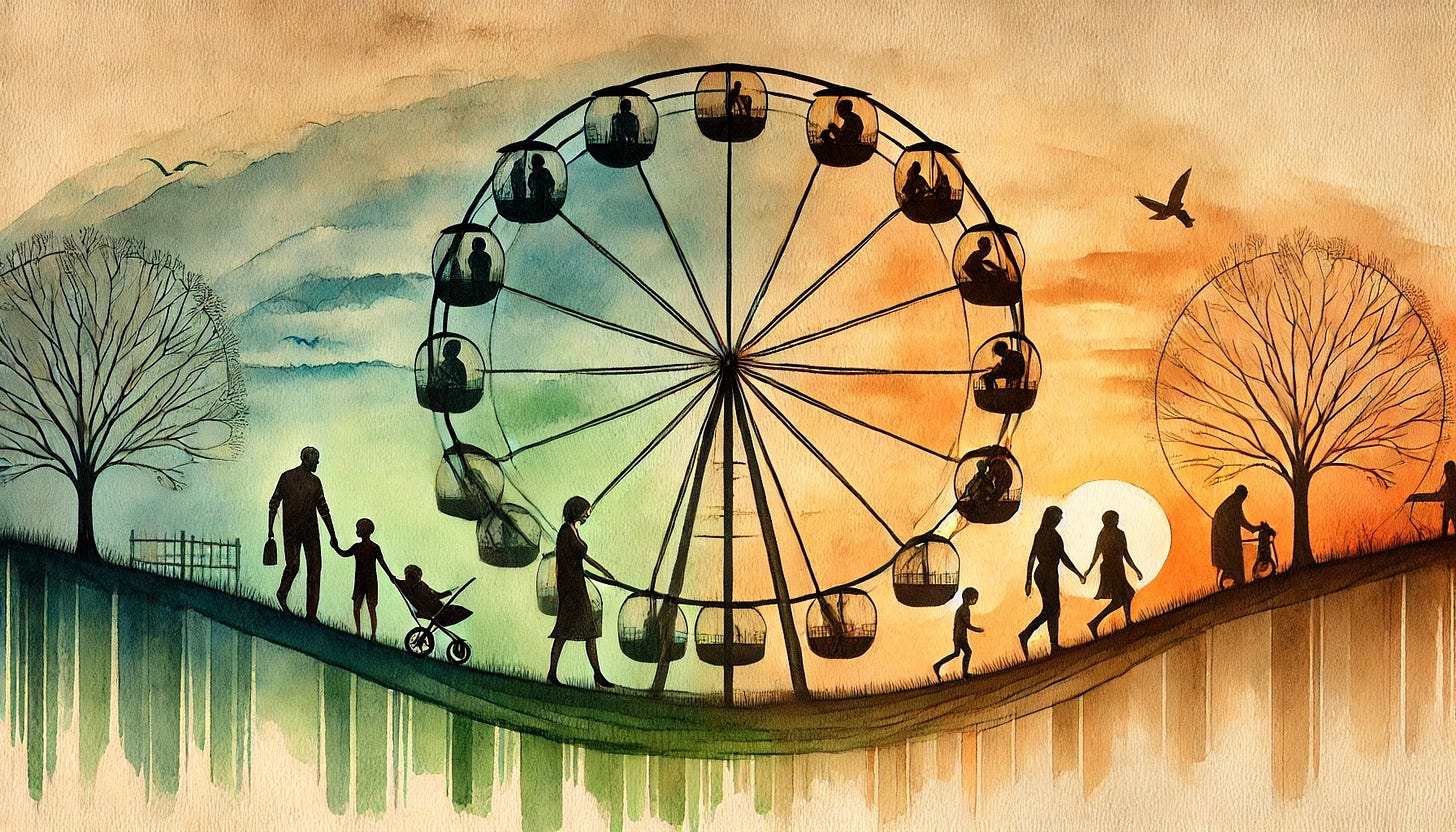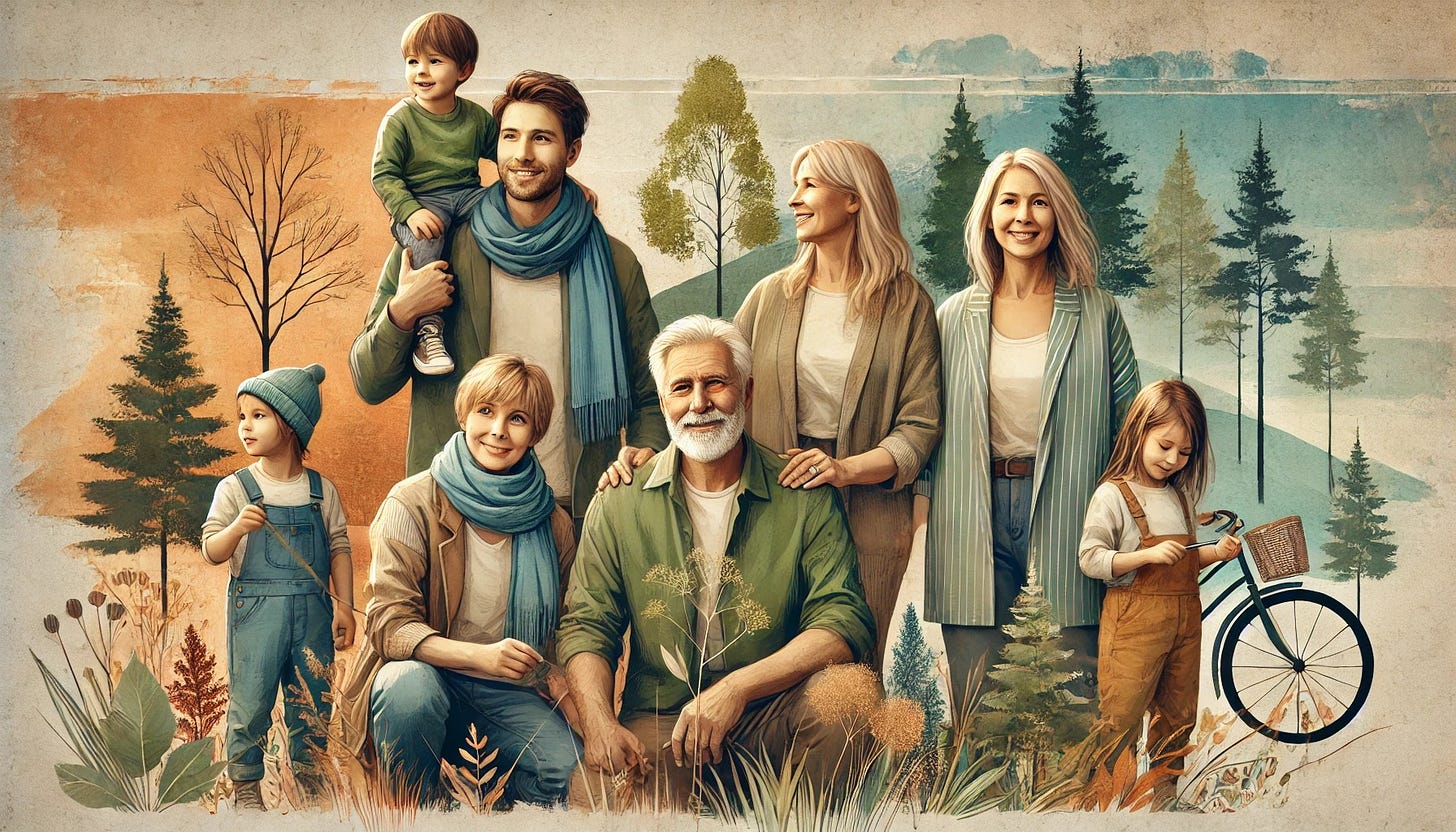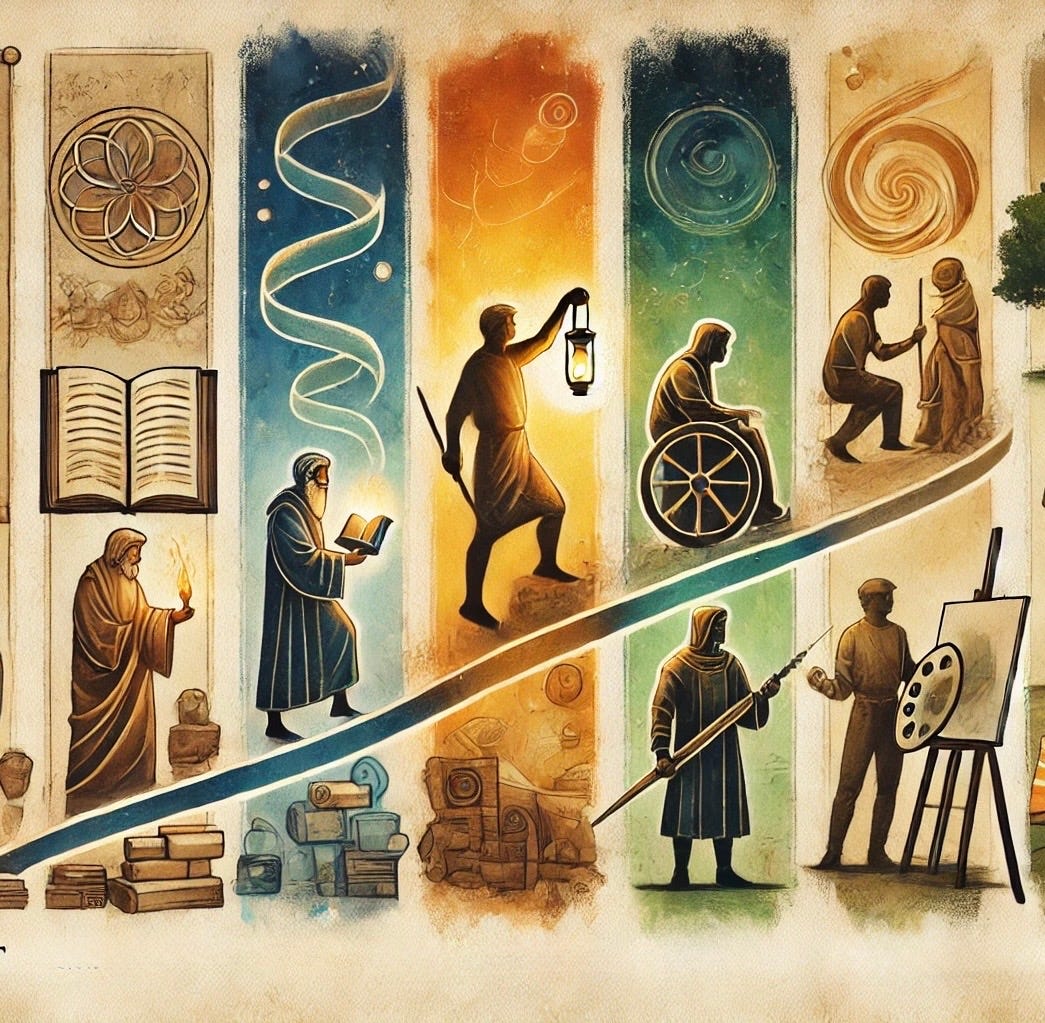Explore generational theories, teaching and parenting styles, and how societal shifts shape digital natives and the future of parenting.
Hey parents, hi educators, wassup counselors. Beans here, building this community of digital natives having the best childhood imaginable.
Last time, we discussed parenting styles and how they shape our children’s personalities. (Catch up here). Today’s post is special — and a bit rigorous — because we’re diving into a topic I spend a lot of time thinking about: Generational Theory.
Ever wonder why your parenting (and teaching) style feels like a reaction to your parents’—or why you find yourself saying, “I’ll never raise my kids like that”? It’s not just you. Parenting and teaching styles run in generational cycles. Let’s explore how these cycles shape who we are—and how we raise.

Have You Seen This Child?
Who does this remind you of?
Ferris Bueller in Ferris Bueller’s Day Off: A quintessential Gen X Nomad in the making, Ferris rebels against institutional rigidity, radiating self-reliance and skepticism. His devil-may-care attitude mirrors a childhood shaped by permissive, hands-off parenting—and teaching—during a time of cultural awakening.
Katniss Everdeen in The Hunger Games: Raised in a dystopian crisis, Katniss epitomizes the Artist Generation’s survival instincts and adaptability. Sheltered and overburdened, her story showcases the emotional weight of growing up in a protective but high-pressure environment, influenced by authoritative parenting and teaching styles.
Generational Theory and Teaching Styles
Generational theory suggests that the parenting and teaching styles we adopt are more than personal—they’re reactive. Every generation seeks to “fix” the perceived mistakes of their parents and teachers, creating cycles that swing between permissiveness, protection, and pragmatism. The Strauss-Howe Generational Theory frames these shifts in four archetypes:
Prophet Generation (Idealists)
Examples: Baby Boomers (b. 1946–1964), Gen Alpha (b. 2013- )
Childhood Environment: Prophets are raised during a High, a period of societal stability and optimism after a crisis. They are nurtured with relaxed and attachment focused parenting, often being idealized as the center of their parents’ post-crisis hope for the future. Seen as “special,” they are encouraged to express themselves, question authority, and pursue their dreams. But their caregivers are inconsistent — sometimes responsive, sometimes neglectful — so Prophets tend to develop insecure-anxious attachment styles.
How They Raise: Tend to raise children during an Unraveling, a period of weakening societal institutions and rising individualism. Prophets tend to focus and tighten up, adopting authoritarian or (more likely) authoritative (high warmth, high structure) teaching and parenting styles, focusing on guiding their children to greatness while offering emotional support. They tend to be aspirational parents, emphasizing personal growth and achievement in their children.
Who They Raise: Prophets parent the Hero Generation, whom they see as destined to lead and solve future crises.
Nomad Generation (Reactives)
Examples: Generation X (b. 1965–1980).
Childhood Environment: Nomads are raised during an Awakening, a time of cultural upheaval and questioning of traditional values. They experience neglectful or permissive parenting, often as latchkey kids with absent or self-absorbed parents. Their upbringing is characterized by instability and independence — a hotbed for mischief — leading to a perception of them as “troublemakers” or “wildcards.” Because their caregivers are emotionally unavailable or dismissive, discouraging emotional expression, Nomads tend to suppress emotions and become self-reliant (insecure-avoidant attachment style).
How They Raise: Tend to raise children during a Crisis, a time of societal upheaval and survival-focused parenting. Reacting to the underprotection they received as children, and to the perceived threats of the Crisis age, Nomads tend to adopt overprotective, authoritative or (more likely) authoritarian (low warmth, high structure) teaching and parenting styles.
Who They Raise: Nomads parent the Artist Generation, whom they see as placid and vulnerable.
Hero Generation (Civics)
Examples: Gen Y / Millennials (b. 1981–1996).
Childhood Environment: Heroes are raised during an Unraveling, a period of weakening societal institutions and rising individualism. They are often surrounded with focused, authoritative parenting and teaching, where structure, rules, and guidance are emphasized alongside warmth. Their parents (Prophets) see them as a source of hope and potential, resulting in encouragement but also high expectations. Because their caregivers are consistently responsive, warm, and attuned to their needs, Heroes tend to develop a secure attachment style.
How They Raise: Heroes tend to relax the style they learned in childhood, and are likely to adopt an authoritative or (more likely) permissive (high warmth, low structure) parenting and teaching style, seeking to avoid the authoritarian excesses of the past while maintaining emotional connection and support. They focus on collaboration and social-emotional growth.
Who They Raise: Heroes raise the Prophet Generation, whom they see as spirited and full of creative worth.
Artist Generation (Adaptives)
Examples: Silent Generation (b. 1928–1945) and Gen Z (b. 1997–2012).
Childhood Environment: Artists are raised during a Crisis, a time of societal upheaval and survival-focused parenting. Their parents are often helicopter or authoritarian, driven by fear and a desire to protect their children in a dangerous world. Artists are sheltered and over-supervised, leading to adaptability but also a tendency to avoid risk. When their caregivers are frightening, abusive, or erratic, creating a paradox for the child — the caregiver is both a source of comfort and fear — Artists develop a disorganized attachment style.
How They Raise: Somewhat self-absorbed, Artists tend to adopt a permissive or (more likely) uninvolved (low warmth, low structure) teaching and parenting style. Their parenting is characterized by instability, but they value harmony and are less likely to enforce rigid boundaries.
Who They Raise: Artists raise the Nomad Generation, whom they see as troublemakers or wildcards.

Factors That Shape Generational Patterns
The intergenerational transmission of parenting and teaching styles isn’t a one-way street. It’s influenced by various factors that can either reinforce or disrupt the cycle:
Reflective Functioning: Parents and teachers who reflect on their own upbringing can break unhealthy patterns. Tools like therapy, self-awareness, and mindful parenting foster secure attachment styles in their children, regardless of their own upbringing.
Partner Influence: A securely attached partner can model healthy emotional behaviors, mitigating tendencies toward insecure attachment in parenting and teaching.
Breakthrough Parenting: Individuals with insecure attachments can consciously create a better environment for their children, fostering secure and supportive relationships to break the cycle of generational insecurity.
Social and Emotional Support: A strong community network provides stability and guidance, especially during tough times, buffering the challenges of parenting and teaching.
Stable Institutions and Culture: Societal stability promotes secure attachment by reducing stress and anxiety. Conversely, times of upheaval often lead to more authoritarian or anxious parenting and teaching styles.
Technology and Economy: Technological and economic developments shape parenting and teaching on a macro scale. From urbanization to digital tools, these shifts influence how parents engage with their children and the resources they access.
Technology as a Catalyst for Generational Change
Psychologist Jean M. Twenge’s book Generations delves into what makes six distinct American generations tick, focusing on how technological advancements drive cultural evolution. Analyzing data from 39 million individuals across 24 national datasets, Twenge illustrates how technology, more than major historical events, shapes the traits, beliefs, and behaviors of each generation.
Baby Boomers (1946–1964):
Traits: Individualistic, expressive, optimistic.
Tech Impact: Grew up with television and early digital technologies.
Cultural Legacy: Champions of civil rights and countercultural shifts.
Generation X (1965–1979):
Traits: Independent, skeptical, entrepreneurial.
Tech Impact: Navigated the rise of personal computers and early internet access.
Cultural Legacy: Redefined work-life balance and embraced innovation.
Millennials (1980–1994):
Traits: Collaborative, socially connected, diverse.
Tech Impact: Immersed in social media, smartphones, constant connectivity.
Cultural Legacy: Advocates for inclusivity, sustainability, workplace transformation.
Generation Z (1995–2012):
Traits: Authentic, socially conscious, mentally health-aware.
Tech Impact: True digital natives with streaming, social media, instant information access.
Cultural Legacy: Prioritizes mental health, social justice, fluid identity expression.
Twenge’s research highlights that technology not only transforms how we live but also how we see ourselves and interact with the world. By reshaping communication styles, work habits, and values, technological progress serves as the defining force behind generational shifts, creating unique identities for each cohort.

A Glimpse at the Next 10 Years
Parenting and teaching are entering a period of seismic change. As we look ahead to the next decade, several trends and cycles are set to redefine what it means to raise children in the digital age. By blending generational theory with emerging societal patterns, we can predict where parenting and teaching might be headed—and how we can prepare for it.
The Rise of Post-Digital Teaching
Digital natives (our kids) will soon be raising their own digital-first children. Unlike Millennials and Gen Xers who grappled with the introduction of social media and smartphones, future teachers will approach technology pragmatically, treating it less as a novelty and more as a tool. We’ll see parents and educators teaching children to manage AI assistants, navigate augmented reality environments, and foster creativity through digital tools, blending screen time with real-world experiences.
The “Slow Parenting” Movement
After decades of intensive parenting and the constant pressure to keep kids competitive, there’s a growing trend toward “slow parenting.” This approach emphasizes fewer extracurriculars, less micromanagement, and more time spent in unstructured play and family connection. Slow parenting could become a dominant ethos as Millennials—who value work-life balance—model a gentler, less pressured way of raising their children and teaching their minds.
AI as a Parenting and Teaching Tool
Artificial intelligence is poised to become an everyday aid for both parenting and teaching. From chatbots that help with school projects to AI-driven social-emotional learning (SEL) platforms that teach empathy, parents and educators will increasingly rely on technology to supplement children’s education and emotional growth. However, this also means navigating ethical dilemmas—ensuring AI is used responsibly, inclusively, and in a way that complements human connection rather than replacing it.
Permissive Teaching Meets Diversity, Equity, and Inclusion (DEI)
The next era of DEI will not feel like a top-down agenda or a cultural war. Instead, it will manifest as permissive teaching. As Gen Z parents and teachers emerge, their focus on social justice will shape how they raise and educate children. Expect a surge in strategies that emphasize inclusivity, teaching children to embrace fluid identities, challenge stereotypes, and advocate for marginalized groups.
Communal Teaching and “Parent Pods”
Economic pressures, like the rising cost of childcare, and the lingering effects of isolation from the pandemic are driving a resurgence of communal parenting and teaching. Families may form tight-knit “parent pods” to share resources, homeschooling responsibilities, and emotional support. This collaborative model could become essential for navigating the challenges of modern parenting and teaching, especially in urban or high-cost areas.
Are We There Yet?
No! We have more work to do.
Generational theory offers profound insights into how parenting and teaching styles shape cultural shifts, but it’s not the whole story. Next, we’ll explore how technology accelerates these generational changes. (Spoiler: Social media isn’t just a tool—it’s a world-shaper.)
In the meantime, I’d love to hear your thoughts on today’s topic. Drop your predictions in the comments, share this post, and join the Digital Natives community as we chart the course for tomorrow’s families. Together, we’re building a legacy for the next generation.
Consider these questions:
Do you recognize yourself or your parenting and teaching style in these generational patterns?
Which generational archetype do you think your kids will embody, and why?
How do you think societal pressures are shaping how we parent and teach today?
What do you see coming for parenting and teaching in the next 10 years?
Comment below, share this post with a friend, and don’t forget to subscribe. Let’s build this revolution together.
You Might Also Like
In our next post, we’ll explore technology and generational change, digging into further Twenge’s theory about how social media impacts digital natives. Until then, check out these resources:
Jean Twenge’s “Generation Tech” Substack: https://open.substack.com/pub/jeanmtwenge
Twenge’s book “Generations”: https://www.jeantwenge.com/generations-book-by-dr-jean-twenge/
Neil Howe’s “Demography Unplugged” Substack: https://open.substack.com/pub/demographyunplugged
Strauss and Howe’s book “Generations”: https://a.co/d/anxkkLY
Strauss and Howe’s book “Millennials & K-12 Schools”: https://a.co/d/ce5CIvu





The exact cutoffs between generations are contested and arbitrary. I was born in 1980: does this make me Gen X or Gen Y? I say I am the eldest Millennial.